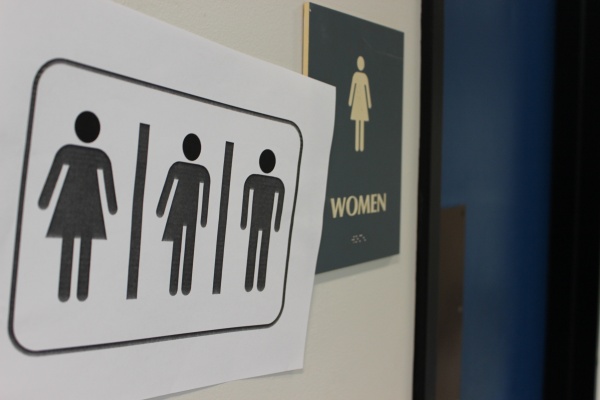All Gender Restroom Initiative Partially Fulfilled
There has been a movement to develop a gender neutral bathroom at Fordham University. (PHOTO ILLUSTRATION BY ZANA NAJJAR/ THE OBSERVER)
November 9, 2015
Fordham Lincoln Center has implemented new signage for the third floor single stall bathrooms in the Leon Lowenstein building. After many meetings between The Positive, a student activist group on campus, and Student Affairs administrators, the signs are void of gender icons, include braille, the latest New York State handicap symbol and simply say “restroom.” The Positive officially requested that the signage read, “All Gender Restroom.”
“As of now, the signs will simply say ‘restroom,’” Eldredge stated. “We actually did some research to see what was out there. I’ve been looking at bathrooms everywhere I go ever since they’ve talked about this.”
The Positive, spearheaded by Chris Hennessy, a transgender male and FCLC ’15, has met periodically with the Dean of Students, Keith Eldredge, and Director of Student Leadership and Community Development (OSLCD) and USG Advisor, Dorothy Wenzel, Ph.D, since December 2014 to push for trans inclusive signage. The Positive began their initiative to bring gender neutral bathrooms with a survey soliciting students’ gender needs on campus. The survey focused on the potential need for all gender bathrooms and was completed by 441 students.
On Aug. 20, Student Affairs presented the signage as reading only ‘restroom.’ On Aug. 27, The Positive requested signage be stalled until further discussion could be had about including some indication that the restroom was an intentional act to be a trans-inclusive space.
“We thought ‘restroom’ was the most inclusive,” Eldredge said. “There doesn’t seem to be a standard term” when it comes to bathroom signage, according to Eldredge.
“I know gender neutral is a term a lot of folks also used. Some people don’t like that language and term because they feel like it negates gender entirely.
“I wanted to encourage people to make the sometimes inconvenient or difficult decisions in order for that welcome to be real. I needed to see that students like me, gender nonconforming folk, are worth making difficult, inconvenient decisions for.”-Chris Hennessy
“Most people believe they have a gender, maybe just not the gender they were born with,” he continued.
Hennessy began, “Removing the gender figures was fine, but there’s currently not the extra step to include ‘all gender restroom’ which was for us vital in order to fulfill the intention of this initiative.”
“For me this was never about bathrooms. Having a restroom I could use without fear was definitely something I wanted. But this was always about more than that,” Hennessy said.
He continued, “After four years of being here I wanted to feel like I did actually belong here. I wanted to encourage people to make the sometimes inconvenient or difficult decisions in order for that welcome to be real. I needed to see that students like me, gender nonconforming folk, are worth making difficult, inconvenient decisions for.”
Members of the Positive are set to meet with Michelle Burris, associate vice president of Student Affairs, to further discuss the possibility of including ‘all gender’ in the new signage.
About the research:
Juan Carlos Matos, the assistant dean and director of the Office of Multicultural Affairs (OMA), headed the research about what Fordham’s peer Jesuit institutions offer in terms of “all gender” restrooms. “We did a two-fold approach,” Matos said. First, OMA looked online for institutions with LGBT resource centers and webpages along with campus maps. They followed up the initial research with phone calls and then emails.
The University of San Francisco was one of the few Jesuit universities that OMA could confirm uses all gender bathroom labeling on single stalled restrooms.
“One thing to note that is interesting in their student union one of the older all gender restrooms signs actually still had the gender symbols while the newer ones in the residence halls I stayed in during the conference, didn’t have any gender icons on them. The newer restrooms just had all gender with two flyers next to them to share information about what they were,” Matos said.
Georgetown University, also a Jesuit institution, has all gender signage on single-stalled bathrooms accompanied by both male and female gender icons and a handicap sign, according to the LGBTQ resource center.
“What I was surprised about, in terms of looking at everything, that the majority of institutions had, anything that would be considered gender neutral or unisex, was more so by design and not necessarily intentional,” Matos continued.
“To couple that, the few that actually say ‘restroom’ accompany with it both gendered icons, some would have a family icon, and all had a handicap symbol,” he said.
What does this mean for other Fordham Campuses?
According to Eldredge, signage will not be changed at this time on any other Fordham campus. It is up to the students at each campus to come forward and request the spaces to possibly implement the new, more gender inclusive signage.
“Identify the bathrooms, help us out, so we can roll out the new signage there as well,” Eldredge said in regards to other Fordham campuses.
When asked why the onus is on students, rather than the facilities department, to locate and update all possible gender inclusive bathrooms, Eldredge responded, “I guess I didn’t think about it that way. I was surprised that the students were only asked about in the third floor.”
“We’re looking for Rose Hill students who want to participate at this stage,” Hennessy said. “We are more than happy to include anyone who is interested in helping to make this a reality.”










